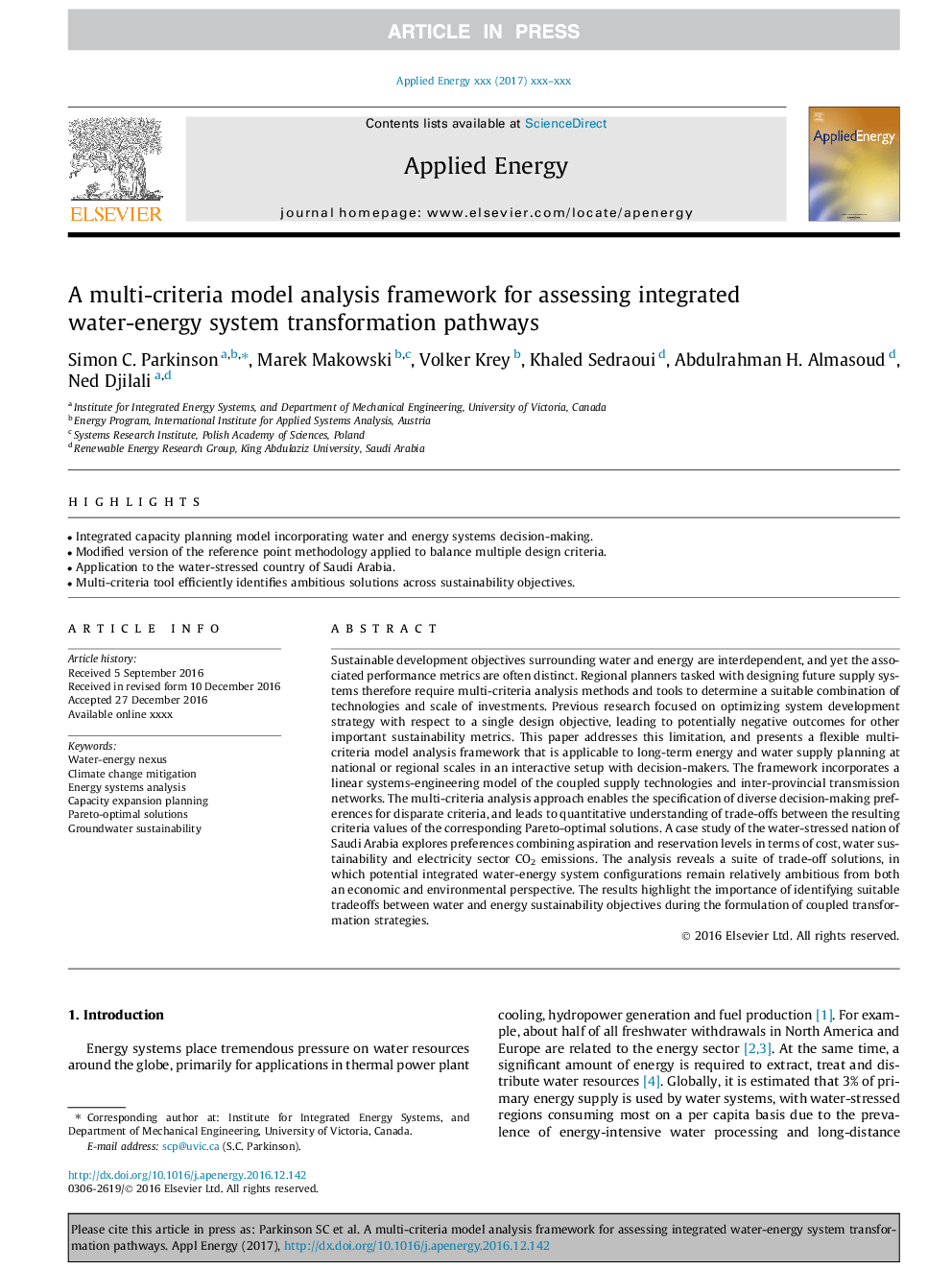| کد مقاله | کد نشریه | سال انتشار | مقاله انگلیسی | نسخه تمام متن |
|---|---|---|---|---|
| 6681263 | 1428080 | 2018 | 10 صفحه PDF | دانلود رایگان |
عنوان انگلیسی مقاله ISI
A multi-criteria model analysis framework for assessing integrated water-energy system transformation pathways
ترجمه فارسی عنوان
چارچوب تجزیه و تحلیل مدل چند معیاره برای ارزیابی مسیرهای تبدیل یک سیستم آب و انرژی
دانلود مقاله + سفارش ترجمه
دانلود مقاله ISI انگلیسی
رایگان برای ایرانیان
کلمات کلیدی
آب و انرژی نکسوس، کاهش تغییرات اقلیمی، تجزیه و تحلیل سیستم های انرژی، برنامه ریزی گسترش ظرفیت، راه حل های بهینه پارتو، پایداری آب زیرزمینی،
ترجمه چکیده
اهداف توسعه پایدار در اطراف آب و انرژی وابسته هستند، ولی معیارهای مربوط به عملکرد اغلب متمایز هستند. بنابراین برنامه ریزان منطقه ای با هدف طراحی سیستم های عرضه آینده، نیازمند روش ها و ابزارهای تحلیل چند معیاری برای تعیین مناسب ترین تکنولوژی و مقیاس سرمایه گذاری هستند. تحقیقات قبلی بر روی بهینه سازی استراتژی توسعه سیستم با توجه به یک هدف طراحی منحصر به فرد، منجر به نتایج بالقوه منفی دیگر معیارهای پایداری شد. این مقاله به این محدودیت اشاره دارد و چهارچوب تجزیه و تحلیل مدل چند معیاره انعطاف پذیر را ارائه می دهد که برای برنامه ریزی طولانی مدت انرژی و آب در مقیاس ملی یا منطقه ای در یک برنامه تعاملی با تصمیم گیرندگان قابل استفاده است. این چارچوب شامل یک سیستم مهندسی خطی مهندسی از فن آوری های عرضه شده همراه و شبکه های انتقال بینالمللی است. رویکرد تجزیه و تحلیل چند معیاره، تعیین ویژگی های تصمیم گیری متنوع را برای معیارهای متمایز می کند و منجر به درک کمی از توافق بین مقادیر معیاری حاصل از راه حل های مناسب بهینه پارتو می شود. مطالعه موردی ملت تحریم شده عربستان سعودی از ترجیحات ترکیبی از آسپیراسیون و سطوح رزرو از لحاظ هزینه، پایداری آب و انتشار گاز دی اکسید کربن است. این تجزیه و تحلیل، مجموعه ای از راه حل های تجاری را نشان می دهد که در آن پیکره بندی سیستم های آب و برق یکپارچه بالقوه از دیدگاه اقتصادی و زیست محیطی نسبتا جاه طلبانه است. نتایج نشان می دهد اهمیت شناسایی معایب مناسب بین اهداف پایداری آب و انرژی در طی فرمول بندی استراتژی های تحول ترکیب شده.
موضوعات مرتبط
مهندسی و علوم پایه
مهندسی انرژی
مهندسی انرژی و فناوری های برق
چکیده انگلیسی
Sustainable development objectives surrounding water and energy are interdependent, and yet the associated performance metrics are often distinct. Regional planners tasked with designing future supply systems therefore require multi-criteria analysis methods and tools to determine a suitable combination of technologies and scale of investments. Previous research focused on optimizing system development strategy with respect to a single design objective, leading to potentially negative outcomes for other important sustainability metrics. This paper addresses this limitation, and presents a flexible multi-criteria model analysis framework that is applicable to long-term energy and water supply planning at national or regional scales in an interactive setup with decision-makers. The framework incorporates a linear systems-engineering model of the coupled supply technologies and inter-provincial transmission networks. The multi-criteria analysis approach enables the specification of diverse decision-making preferences for disparate criteria, and leads to quantitative understanding of trade-offs between the resulting criteria values of the corresponding Pareto-optimal solutions. A case study of the water-stressed nation of Saudi Arabia explores preferences combining aspiration and reservation levels in terms of cost, water sustainability and electricity sector CO2 emissions. The analysis reveals a suite of trade-off solutions, in which potential integrated water-energy system configurations remain relatively ambitious from both an economic and environmental perspective. The results highlight the importance of identifying suitable tradeoffs between water and energy sustainability objectives during the formulation of coupled transformation strategies.
ناشر
Database: Elsevier - ScienceDirect (ساینس دایرکت)
Journal: Applied Energy - Volume 210, 15 January 2018, Pages 477-486
Journal: Applied Energy - Volume 210, 15 January 2018, Pages 477-486
نویسندگان
Simon C. Parkinson, Marek Makowski, Volker Krey, Khaled Sedraoui, Abdulrahman H. Almasoud, Ned Djilali,
